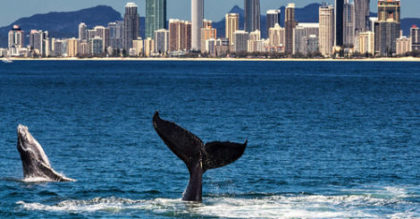
 )
)If taking dogs for walks in the name of science is too pedestrian for you, how about finding your inner Ahab on the high seas, pursuing whales with a crossbow? Don’t worry, the goal is not to kill the whales. The crossbows are designed to collect blubber samples. Those samples will be used to assess stress levels in humpback whales near the coast of California, to see if the recent reduction in boat traffic and noise has improved the whales’ quality of life.
This whaling adventure is just one of many studies seeking to understand the impacts we humans have on all the other living things around us by studying what changes when we’re around less. As humans take an “anthropause,” animals are experiencing changes in food availability, shifts in territory to explore, and all around fewer disruptions and less noise. Some changes seem clearly beneficial, like more places becoming available for sea turtles to lay eggs because beaches are less crowded. Others need closer study because the impact is less clear. Consider all the wild animals who supplement their diet with human food, via trash or litter or direct feeding. With fewer tourists handing out treats, will they go back to food sources better matched to their physiology or will they face a shortage of calories? Food web ecology can be complex; results may vary for different species and populations, and may not always be intuitive.
While we’re learning more about animals and our impacts on them, we can learn something from them as well. As this interview discusses, many animals exhibit some form of distancing or avoidance that reduces the likelihood of diseases spreading. In some cases, healthy individuals stay away from ones who shows signs of illness. In other species, the sick individuals will remove themselves from the group. The result in both scenarios is fewer interactions between susceptible and infected individuals, which limits how quickly and widely a pathogen can spread.
In fairness, humans often do this too, either instinctively or as a learned behavior. We recognize a variety of symptoms and know to avoid people exhibiting them. This is one reason why some severe infections aren’t more contagious, because they have such visible effects that the value of isolation is clear. This creates a situation in which less virulent variations, ones that cause less severe illness, will spread more readily, and so over time some pathogens will evolve in that direction. Likewise, hosts who avoid sick individuals are more likely to survive as a population, making it plausible for such behaviors to evolve adaptively. Perhaps a more interesting question is whether there is any selectable advantage to exhibiting visible symptoms. Did looking sick evolve adaptively, or is it simply a direct consequence of the symptoms?
One of the significant challenges posed by our present circumstance is the lack of cues for avoidance. With SARS-CoV-2, a person can be contagious for days before symptoms are apparent even to them. Hence the need for widespread distancing and mask wearing, a solution it is hard to imagine most animal populations being able to implement. Indeed, it is unclear how they would even be able to detect the circumstances that would warrant such a solution. For that reason, perhaps a behavioral response to such pathogens couldn’t evolve via a purely biological pathway; perhaps it requires first developing technological senses like RT-PCR to even exist as a phenotype.
Andy has worn many hats in his life. He knows this is a dreadfully clichéd notion, but since it is also literally true he uses it anyway. Among his current metaphorical hats: husband of one wife, father of two teenagers, reader of science fiction and science fact, enthusiast of contemporary symphonic music, and chief science officer. Previous metaphorical hats include: comp bio postdoc, molecular biology grad student, InterVarsity chapter president (that one came with a literal hat), music store clerk, house painter, and mosquito trapper. Among his more unique literal hats: British bobby, captain’s hats (of varying levels of authenticity) of several specific vessels, a deerstalker from 221B Baker St, and a railroad engineer’s cap. His monthly Science in Review is drawn from his weekly Science Corner posts — Wednesdays, 8am (Eastern) on the Emerging Scholars Network Blog. His book Faith across the Multiverse is available from Hendrickson.

Leave a Reply